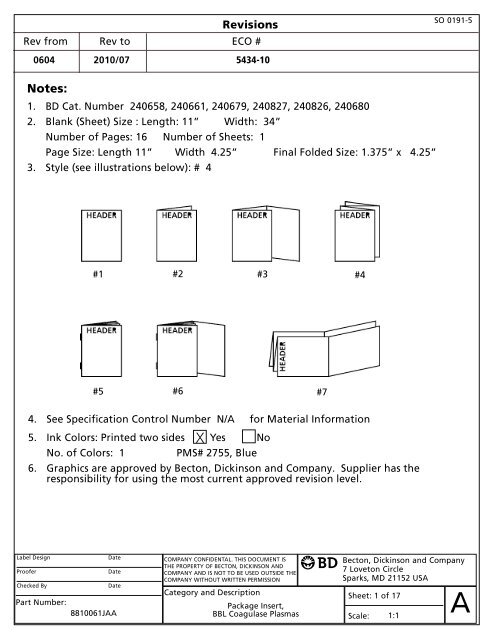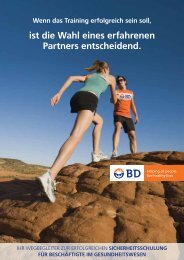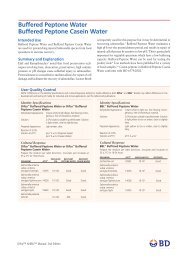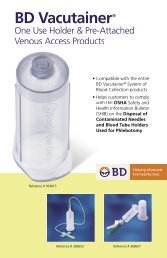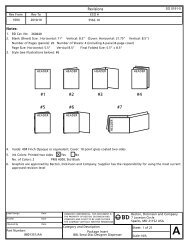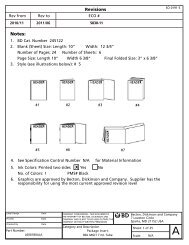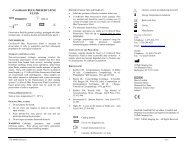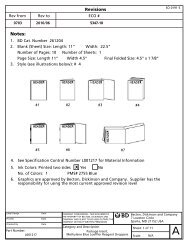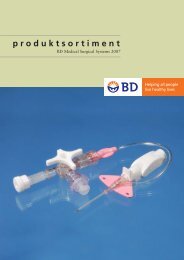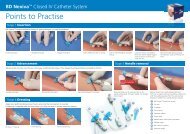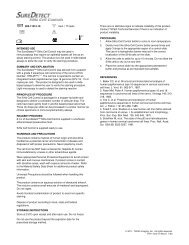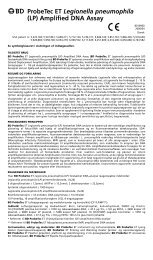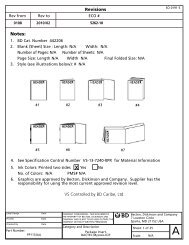BBL Coagulase Plasmas - BD
BBL Coagulase Plasmas - BD
BBL Coagulase Plasmas - BD
You also want an ePaper? Increase the reach of your titles
YUMPU automatically turns print PDFs into web optimized ePapers that Google loves.
Revisions<br />
Rev from Rev to ECO #<br />
0604 2010/07 5434-10<br />
Notes:<br />
1. <strong>BD</strong> Cat. Number 240658, 240661, 240679, 240827, 240826, 240680<br />
2. Blank (Sheet) Size : Length: 11” Width: 34”<br />
Number of Pages: 16 Number of Sheets: 1<br />
Page Size: Length 11” Width 4.25” Final Folded Size: 1.375” x 4.25”<br />
3. Style (see illustrations below): # 4<br />
#1 #2 #3 #4<br />
#5 #6 #7<br />
4. See Specification Control Number N/A for Material Information<br />
X<br />
5. Ink Colors: Printed two sides Yes No<br />
No. of Colors: 1 PMS# 2755, Blue<br />
6. Graphics are approved by Becton, Dickinson and Company. Supplier has the<br />
responsibility for using the most current approved revision level.<br />
Label Design Date<br />
Proofer Date<br />
Checked By Date<br />
Part Number:<br />
8810061JAA<br />
COMPANY CONFIDENTAL. THIS DOCUMENT IS<br />
THE PROPERTY OF BECTON, DICKINSON AND<br />
COMPANY AND IS NOT TO BE USED OUTSIDE THE<br />
COMPANY WITHOUT WRITTEN PERMISSION<br />
SO 0191-5<br />
Category and Description<br />
Package Insert,<br />
Becton, Dickinson and Company<br />
7 Loveton Circle<br />
Sparks, MD 21152 USA<br />
Sheet: 1 of 17<br />
<strong>BBL</strong> <strong>Coagulase</strong> <strong>Plasmas</strong> Scale: 1:1<br />
A
� <strong>BBL</strong> <strong>Coagulase</strong> <strong>Plasmas</strong><br />
� 8810061JAA<br />
2010/07<br />
English: pages 1 – 4 Italiano: pagine 9 – 12<br />
Français : pages 4 – 6 Español: páginas 12 – 15<br />
Deutsch: Seiten 6 – 9<br />
INTENDED USE<br />
<strong>BBL</strong> <strong>Coagulase</strong> Plasma, Rabbit and <strong>BBL</strong> <strong>Coagulase</strong> Plasma, Rabbit with EDTA are<br />
used to qualitatively determine the pathogenicity of staphylococci using the direct<br />
tube method.<br />
SUMMARY AND EXPLANATION<br />
Identification of staphylococci is based on microscopic examination, colonial<br />
morphology and cultural and biochemical characteristics. Staphylococci associated<br />
with acute infection (Staphylococcus aureus in humans and S. intermedius and<br />
S. hyicus in animals) can clot plasma. The most widely used and generally accepted<br />
criterion for identification of these pathogenic organisms is based on the presence<br />
of the enzyme coagulase. 1 The ability of Staphylococcus to produce coagulase was<br />
first reported by Loeb2 in 1903.<br />
<strong>Coagulase</strong> binds plasma fibrinogen, causing the organisms to agglutinate or plasma<br />
to clot. Two different forms of coagulase can be produced, free and bound. Free<br />
coagulase is an extracellular enzyme produced when the organism is cultured in<br />
broth. Bound coagulase, also known as clumping factor, remains attached to the cell<br />
wall of the organism. The tube test can detect the presence of both bound and free<br />
coagulase. Isolates that do not produce clumping factor must be tested for the<br />
ability to produce extracellular coagulase (free coagulase).<br />
<strong>BBL</strong> <strong>Coagulase</strong> Plasma, Rabbit and <strong>BBL</strong> <strong>Coagulase</strong> Plasma Rabbit with EDTA are<br />
recommended for performing the direct tube test. The inoculum used for testing<br />
must be pure because a contaminant may produce false results after prolonged<br />
incubation. For the coagulase test, <strong>BBL</strong> <strong>Coagulase</strong> Plasma, Rabbit with EDTA is<br />
superior to citrated plasma because citrate-utilizing organisms such as Pseudomonas<br />
species, Serratia marcescens, Enterococcus faecalis and strains of Streptococcus will<br />
clot citrated plasma in 18 h. 3<br />
PRINCIPLES OF THE PROCEDURE<br />
S. aureus produces two types of coagulase, free and bound. Free coagulase is an<br />
extracellular enzyme produced when the organism is cultured in broth. Bound<br />
coagulase, also known as the clumping factor, remains attached to the cell wall of<br />
the organism.<br />
In the direct tube test, free coagulase liberated from the cell acts on prothrombin in<br />
the coagulase plasma to give a thrombin-like product. This product then acts on<br />
fibrinogen to form a fibrin clot. 4<br />
The tube test is performed by mixing an overnight broth culture or colonies from a<br />
non-inhibitory agar plate into a tube of rehydrated coagulase plasma. The tube is<br />
incubated at 37°C. The formation of a clot in the plasma indicates coagulase<br />
production.<br />
REAGENTS<br />
<strong>Coagulase</strong> Plasma, Rabbit is lyophilized rabbit plasma with 0.85% sodium citrate and<br />
0.85% sodium chloride, approximately.<br />
<strong>Coagulase</strong> Plasma, Rabbit with EDTA is lyophilized rabbit plasma with 0.15% EDTA<br />
(ethylenediaminetetraacetic acid) and 0.85% sodium chloride, approximately.<br />
Warnings and Precautions<br />
For in vitro Diagnostic Use.<br />
The Packaging of This Product Contains Dry Natural Rubber.<br />
Observe aseptic technique and established precautions against microbiological<br />
hazards throughout all procedures. After use, specimens, containers, slides, tubes<br />
and other contaminated material must be sterilized by autoclaving.<br />
Directions for use should be followed carefully.<br />
Storage<br />
Store unopened lyophilized <strong>BBL</strong> <strong>Coagulase</strong> Plasma, Rabbit and <strong>BBL</strong> <strong>Coagulase</strong><br />
Plasma, Rabbit with EDTA at 2 – 8°C.<br />
Store reconstituted plasma at 2 – 8°C for up to 14 days, or aliquot and freeze promptly<br />
at -20°C for up to 30 days. Do not thaw and refreeze.<br />
Expiration date applies to product in its intact container when stored as directed. Do<br />
not use if the product is caked, discolored or shows other signs of deterioration.<br />
Examine reconstituted reagents for evidence of contamination, evaporation or other<br />
signs of deterioration, such as cloudiness or partial clotting.<br />
SPECIMEN COLLECTION AND PREPARATION<br />
Collect specimens or samples in sterile containers or with sterile swabs and transport<br />
immediately to the laboratory according to recommended guidelines. 1,4-9<br />
Process each specimen using procedures appropriate for that sample. 1,4-9
Select well-isolated colonies. The test described below requires the use of a pure test<br />
culture.<br />
Suspicious growth, such as black colonies on Vogel and Johnson Agar or Tellurite<br />
Glycine Agar, or golden, hemolytic colonies from Trypticase Soy Blood agar plates<br />
should be selected for testing.<br />
Using a bacteriological loop, transfer a well-isolated colony from a pure culture into<br />
a tube of sterile Brain Heart Infusion Broth or Trypticase Soy Broth. Incubate for<br />
18 – 24 h or until a dense growth is observed. Alternatively, 2 – 4 colonies (1 loopful)<br />
taken directly from a non-inhibitory agar plate such as Trypticase Soy Agar may be<br />
used as an inoculum instead of a broth culture.<br />
PROCEDURE<br />
Materials Provided: <strong>BBL</strong> <strong>Coagulase</strong> Plasma, Rabbit, <strong>BBL</strong> <strong>Coagulase</strong> Plasma, Rabbit<br />
with EDTA.<br />
Materials Required But Not Provided: Bacteriological inoculating loop, Pipettes,<br />
Sterile purified water, Culture tubes, small (10 x 75 mm), Water bath or incubator<br />
(35 – 37°C), Trypticase Soy Broth or Brain Heart Infusion (BHI) Broth.<br />
Reagent Preparation<br />
Rehydrate <strong>BBL</strong> <strong>Coagulase</strong> Plasma, Rabbit and <strong>BBL</strong> <strong>Coagulase</strong> Plasma, Rabbit with<br />
EDTA by adding sterile purified water to the vial as indicated below. Mix by gentle<br />
end-over-end rotation of the vial.<br />
Product Size Sterile Purified Water Approximate Number of Tests<br />
3 mL 3 mL 6<br />
15 mL 15 mL 30<br />
25 mL<br />
Test Procedure<br />
25 mL 50<br />
1. Using a sterile 1 mL pipette, add 0.5 mL of rehydrated <strong>BBL</strong> <strong>Coagulase</strong> Plasma,<br />
Rabbit or <strong>BBL</strong> <strong>Coagulase</strong> Plasma, Rabbit with EDTA to a 10 x 75 mm test tube<br />
supported in a rack.<br />
2. Using a sterile 1 mL serological pipette, add approximately 0.05 mL of the<br />
overnight broth culture of the test organism to the tube of plasma. Alternatively,<br />
using a sterile bacteriological loop, thoroughly emulsify 2 – 4 colonies (1 loopful)<br />
from a non-inhibitory agar plate in the tube of plasma.<br />
3. Mix gently.<br />
4. Incubate in a water bath or incubator at 35 – 37°C for up to 4 h.<br />
5. Examine the tubes periodically by gently tipping the tube. Avoid shaking or<br />
agitating the tube, which could cause breakdown of the clot and, consequently,<br />
doubtful or false negative test results. Any degree of clotting in a 3 – 4 h period<br />
is regarded as a positive result. Many weak enzyme-producing strains will<br />
coagulate the plasma only after 24 h of incubation.<br />
6. Record results.<br />
User Quality Control<br />
At the time of use, test both positive and negative control cultures to check<br />
performance of the coagulase plasma, techniques and methodology. The following<br />
cultures listed are the minimum that should be used for performance testing.<br />
Organism ATCC Reaction<br />
Staphylococcus aureus 25923 Clot in tube<br />
Staphylococcus epidermidis 12228 No clot in tube<br />
Quality control requirements must be performed in accordance with applicable local,<br />
state and/or federal regulations or accreditation requirements and your laboratory’s<br />
standard Quality Control procedures. It is recommended that the user refer to pertinent<br />
NCCLS guidance and CLIA regulations for appropriate Quality Control practices.<br />
Results<br />
Any degree of clotting in <strong>BBL</strong> <strong>Coagulase</strong> Plasma, Rabbit or <strong>BBL</strong> <strong>Coagulase</strong> Plasma,<br />
Rabbit with EDTA is considered a positive test. The following chart can be used as a<br />
guide in interpreting the reactions.<br />
Negative Positive<br />
1+ 2+ 3+ 4+<br />
Negative No evidence of fibrin formation<br />
1 + Positive Small unorganized clots<br />
2 + Positive Small organized clot<br />
3 + Positive Large organized clot<br />
4 + Positive Entire content of tube coagulates and is not displaced when tube is<br />
inverted.<br />
LIMITATIONS OF THE PROCEDURE<br />
1. Some species of organisms utilize citrate in their metabolism and will yield falsepositive<br />
reactions for coagulase activity. Normally, this does not cause problems<br />
since the coagulase test is performed almost exclusively on staphylococci.<br />
However, it is possible that bacteria that utilize citrate may contaminate<br />
Staphylococcus cultures on which the coagulase test is being performed. These<br />
contaminated cultures may, upon prolonged incubation, give false-positive<br />
results due to citrate utilization. 4<br />
2. When checking results of the coagulase test, observe tubes hourly during the<br />
first 4 h of incubation. Some strains of S. aureus produce staphylokinase, which<br />
may lyse clots. If the tubes are not read until 24 h of incubation, false-negative<br />
results may occur. 1<br />
3. Do not use plasma if a heavy precipitate or clot has formed before inoculation.<br />
2
PERFORMANCE CHARACTERISTICS 10,11<br />
The performance of Bacto <strong>Coagulase</strong> Plasma (now <strong>BBL</strong> <strong>Coagulase</strong> Plasma) was<br />
compared to four other tests for the identification of Staphylococcus aureus in a<br />
study by Ad Luijenkijk, van Belkum, Verbrugh and Kluytmans. 10 The free-coagulase<br />
(tube) test was performed. In addition, the bound coagulase (agar) test and three<br />
commercial latex agglutination tests were used to identify isolates.<br />
Of the 330 staphylococcal isolates tested, 300 were S. aureus and 30 were non-<br />
S. aureus. All of the tests produced negative results for the 30 non-S. aureus isolates<br />
for a specificity of 100%. The table below summarizes the sensitivity of each test<br />
system for the 300 S. aureus isolates.<br />
MSSA* (222 isolates) MRSA**(78 isolates) Total (300 isolates)<br />
No. of Test No. of Test No. of Test<br />
Test<br />
falsenegative<br />
Sensitivity<br />
(%)<br />
falsenegative<br />
Sensitivity<br />
(%)<br />
falsenegative<br />
Sensitivity<br />
(%)<br />
results results results<br />
Free<br />
<strong>Coagulase</strong><br />
0 100 6 92.3 6 98.0<br />
Bound<br />
<strong>Coagulase</strong><br />
Latex<br />
0 100 3 96.1 3 99.0<br />
Agglutination<br />
Test #1<br />
Latex<br />
0 100 0 100 0 100<br />
Agglutination<br />
Test #2<br />
Latex<br />
2 99.1 12 84.6 14 95.3<br />
Agglutination<br />
Test #3<br />
0 100 0 100 0 100<br />
*Methicillin-susceptible S. aureus.<br />
**Methicillin-resistant S. aureus.<br />
In a second study by McDonald and Chapin, 11 the performance of <strong>BBL</strong> <strong>Coagulase</strong><br />
Plasma was compared in a 2-h tube coagulase test (TCT) to two commercial latex<br />
agglutination tests for identifying S. aureus directly from blood culture broths and<br />
pellets obtained from supernatants of BACTEC bottles. One hundred twelve (112)<br />
clinical blood culture isolates and 68 negative blood culture bottles seeded with a<br />
variety of gram-positive organisms were evaluated.<br />
The table below gives the results of the coagulase test and the latex agglutination<br />
tests for both the seeded and clinical specimens.<br />
No. of positive results<br />
Cultures and organism(s) No. aerobic/ Direct Pellet<br />
No. anaerobic Latex Latex Latex Latex<br />
(total) Test #1 Test #2 TCT Test #1 Test #2 TCT<br />
Seeded<br />
Staphylococcus aureus 11/8 (19) 0 0 19 2 2 19<br />
<strong>Coagulase</strong>-negative<br />
staphylococci<br />
9/9 (18) 0 0 0 0 0 0<br />
Streptococcus pneumoniae 5/5 (10) 0 0 0 0 0 0<br />
Enterococcus spp. 6/5 (11) 5 5 0 5 5 0<br />
Streptococcus agalactiae 3/5 (8) 0 0 0 0 0 0<br />
Streptococcus pyogenes<br />
Clinical<br />
1/1 (2) 0 0 0 0 0 0<br />
<strong>Coagulase</strong>-negative<br />
staphylococci<br />
70/3 (73) 0 0 0 0 0 0<br />
Staphylococcus aureus 35/4 (39) 5 4 31 5 4 30<br />
Among the 68 seeded blood culture bottles, the 2-h tube coagulase test using <strong>BBL</strong><br />
<strong>Coagulase</strong> Plasma correctly identified 19 of 19 blood cultures seeded with S. aureus.<br />
There were no false positives with the 2-h tube coagulase test. Among the 112 clinical<br />
specimens tested, the 2-h tube coagulase test correctly identified 31 out of 39 S.<br />
aureus isolates directly in blood culture broth and 30 out of 39 S. aureus isolates in<br />
pelleted supernatants, for sensitivities of 79.5 and 76.9%, respectively. The specificity<br />
with both seeded and clinical isolates was 100% for the tube coagulase test.<br />
AVAILABILITY<br />
Cat. No. Description<br />
240658 <strong>BBL</strong> <strong>Coagulase</strong> Plasma, Rabbit, 10 X 3.0 mL<br />
240661 <strong>BBL</strong> <strong>Coagulase</strong> Plasma, Rabbit, 10 X 15.0 mL<br />
240679 <strong>BBL</strong> <strong>Coagulase</strong> Plasma, Rabbit, 10 X 25.0 mL<br />
240827 <strong>BBL</strong> <strong>Coagulase</strong> Plasma, Rabbit with EDTA, 10 X 3.0 mL<br />
240826 <strong>BBL</strong> <strong>Coagulase</strong> Plasma, Rabbit with EDTA, 10 X 15.0 mL<br />
240680 <strong>BBL</strong> <strong>Coagulase</strong> Plasma, Rabbit with EDTA, 10 X 25.0 mL<br />
REFERENCES<br />
1. Kloos, W. E., and T. L. Bannerman. 1999. Staphylococcus and Micrococcus,<br />
p. 264-282. In P.R. Murray, P.R., E.J. Baron, M.A. Pfaller, F.C. Tenover and R.H.<br />
Yolken, Manual of clinical microbiology, 7th ed. American Society for<br />
Microbiology, Washington, D.C.<br />
2. Loeb, L. 1903. The influence of certain bacteria on the coagulation of the blood.<br />
J. Med. Res. 10:407-419.<br />
3. Bayliss, B.G. and E.R. Hall. 1965. Plasma coagulation by organisms other than<br />
Staphylococcus aureus. J. Bacteriol. 89:101-104.<br />
4. Pezzlo, M. (ed.). 1994. Aerobic bacteriology, p. 1.0.0.-1.20.47. In H. D. Isenberg<br />
(ed.), Clinical microbiology procedures handbook, vol. 1. American Society for<br />
Microbiology, Washington, D.C.<br />
5. Baron, E.J., L.R. Peterson and S.M. Finegold. 1994. Bailey & Scott’s diagnostic<br />
microbiology, 9th ed. Mosby-Year Book, Inc., St. Louis, MO.<br />
6. Association of Official Analytical Chemists. 2000. Official methods of analysis of<br />
AOAC International, 17th ed. AOAC International, Arlington, VA.<br />
7. Association of Official Analytical Chemists. 2001. FDA Bacteriological analytical<br />
manual online. .<br />
8. Downes, F.P. and K. Ito (ed.). 2001. Compendium of methods for the<br />
microbiological examination of foods, 4th ed. American Public Health<br />
Association, Washington, D.C.<br />
3
9. Flowers, R.S., W. Andrews, C.W. Donnelly and E. Koenig. 1993. Pathogens in milk<br />
and milk products, p. 103-212. In R.T. Marshall (ed.), Standard methods for the<br />
examination of dairy products, 16th ed. American Public Health Association,<br />
Washington, D.C.<br />
10. Luijendijk, A., A. van Belkum, H. Verbrugh and J. Kluytmans. 1996. Comparison<br />
of five tests for identification of Staphylococcus aureus from clinical samples.<br />
J. Clin. Microbiol. 34:2267-2269.<br />
11. McDonald, C.L. and K. Chapin. 1995. Rapid Identification of Staphylococcus<br />
aureus from blood culture bottles by a classic 2-hour tube coagulase test. J. Clin.<br />
Microbiol. 33:50-52.<br />
� <strong>BBL</strong> <strong>Coagulase</strong> <strong>Plasmas</strong> Français<br />
APPLICATION<br />
Le <strong>BBL</strong> <strong>Coagulase</strong> Plasma, Rabbit (plasma de lapin pour test de la coagulase <strong>BBL</strong>) et<br />
le <strong>BBL</strong> <strong>Coagulase</strong> Plasma, Rabbit with EDTA (plasma de lapin avec EDTA pour test de<br />
la coagulase <strong>BBL</strong>) servent à déterminer qualitativement la pathogénicité des<br />
staphylocoques par la méthode directe en tube.<br />
RESUME ET EXPLICATION<br />
L’identification des staphylocoques est basée sur l’examen microscopique, la<br />
morphologie des colonies, ainsi que les caractéristiques en culture et les<br />
caractéristiques biochimiques. Les staphylocoques associés à une infection aiguë<br />
(Staphylococcus aureus chez l’homme et S. intermedius et S. hyicus chez l’animal) ont<br />
la propriété de coaguler le plasma. Le critère le plus largement utilisé et<br />
habituellement accepté d’identification de ces microorganismes pathogènes est basé<br />
sur la présence de l’enzyme coagulase. 1 La capacité de Staphylococcus à produire de<br />
la coagulase a été rapportée pour la première fois par Loeb2 en 1903.<br />
La coagulase se lie au fibrinogène plasmatique, provoquant l’agglutination des<br />
microorganismes ou la coagulation du plasma. La coagulase existe sous deux<br />
formes : libre et liée. La coagulase libre est un enzyme extracellulaire produit par<br />
le microorganisme cultivé en bouillon. La coagulase liée, également appelée<br />
facteur d’agglutination, demeure attachée à la paroi cellulaire du microorganisme.<br />
Le test en tube peut détecter la présence des formes liée et libre de la coagulase.<br />
Lorsque les isolats ne produisent pas de facteur d’agglutination, il convient de<br />
tester leur capacité à produire de la coagulase extracellulaire (coagulase libre).<br />
Le <strong>BBL</strong> <strong>Coagulase</strong> Plasma, Rabbit et le <strong>BBL</strong> <strong>Coagulase</strong> Plasma, Rabbit with EDTA sont<br />
recommandés pour réaliser la méthode directe en tube. L’inoculum utilisé pour le<br />
test doit provenir d’une culture pure car un contaminant risque de fausser les<br />
résultats après une incubation prolongée. Le <strong>BBL</strong> <strong>Coagulase</strong> Plasma, Rabbit with<br />
EDTA est supérieur au plasma au citrate pour réaliser le test de la coagulase, car les<br />
microorganismes métabolisant le citrate, comme les espèces de Pseudomonas,<br />
Serratia marcescens, Enterococcus faecalis et des souches de Streptococcus, coagulent<br />
le plasma citraté en 18 h. 3<br />
PRINCIPES DE LA METHODE<br />
S. aureus produit deux types de coagulase : libre et liée. La coagulase libre est un<br />
enzyme extracellulaire produit par le microorganisme cultivé en bouillon. La coagulase<br />
liée, également appelée facteur d’agglutination, demeure attachée à la paroi cellulaire<br />
du microorganisme.<br />
Dans la méthode directe en tube, la coagulase libre libérée de la cellule agit sur la<br />
prothrombine contenue dans le <strong>Coagulase</strong> Plasma pour former un produit analogue<br />
à la thrombine. Ce produit réagit ensuite sur le fibrinogène pour former un caillot<br />
de fibrine. 4<br />
La méthode en tube consiste à mélanger une culture en bouillon de la veille ou des<br />
colonies prélevées sur une boîte de gélose non inhibitrice dans un tube de <strong>Coagulase</strong><br />
Plasma réhydraté. Le tube est incubé à 37 °C. La formation d’un caillot dans le plasma<br />
indique une production de coagulase.<br />
REACTIFS<br />
Le <strong>Coagulase</strong> Plasma, Rabbit est un plasma de lapin lyophilisé contenant environ<br />
0,85 % de citrate de sodium et 0,85 % de chlorure de sodium.<br />
Le <strong>Coagulase</strong> Plasma, Rabbit with EDTA est un plasma de lapin lyophilisé contenant<br />
environ 0,15 % d’EDTA (acide éthylène diamine tétra acétique) et 0,85 % de chlorure<br />
de sodium.<br />
Avertissements et précautions<br />
Réservé au diagnostic in vitro.<br />
L’emballage de ce produit contient du caoutchouc naturel sec.<br />
Respecter les techniques d’asepsie et prendre les précautions habituelles contre les<br />
dangers microbiologiques pendant les préparations. Après utilisation, stériliser à<br />
l’autoclave les échantillons, les récipients, les lames, les tubes et les autres matériels<br />
contaminés.<br />
Respecter scrupuleusement le mode d’emploi.<br />
Conservation<br />
Conserver le <strong>BBL</strong> <strong>Coagulase</strong> Plasma, Rabbit et le <strong>BBL</strong> <strong>Coagulase</strong> Plasma, Rabbit with<br />
EDTA lyophilisé non ouverts à 2 – 8 °C.<br />
Le plasma reconstitué se conserve à 2 – 8 °C jusqu’à 14 jours, ou aliquoté et congelé<br />
immédiatement à -20 °C jusqu’à 30 jours. Ne pas recongeler une fois décongelé.<br />
La date de péremption s’applique au produit contenu dans son emballage intact et<br />
conservé conformément aux instructions. Ne pas utiliser le produit s’il présente un<br />
aspect agglutiné ou décoloré, ou d’autres signes de détérioration. S’assurer que les<br />
réactifs reconstitués ne présentent pas de signes de contamination ou d’évaporation,<br />
ou d’autres signes de détérioration (turbidité ou coagulation partielle).<br />
PRELEVEMENT ET PREPARATION DES ECHANTILLONS<br />
Recueillir les échantillons dans des récipients stériles ou effectuer des prélèvements<br />
à l’aide d’écouvillons stériles et les acheminer immédiatement jusqu’au laboratoire<br />
conformément aux consignes en vigueur. 1,4-9<br />
Préparer chaque échantillon comme il convient. 1,4-9<br />
4
Sélectionner les colonies bien isolées. Le test décrit ci-dessous nécessite une culture pure.<br />
Tester les colonies suspectes, comme des colonies noires sur gélose de Vogel et<br />
Johnson ou gélose à la glycine et à la tellurite, ou des colonies hémolytiques dorées<br />
sur gélose de soja au sang Trypticase Soy Blood Agar.<br />
A l’aide d’un ensemenceur à anse, transférer une colonie bien isolée prélevée sur une<br />
culture pure dans un tube de bouillon cœur-cervelle Brain Heart Infusion Broth ou<br />
de bouillon de soja Trypticase Soy Broth. Incuber pendant 18 – 24 h ou jusqu’à<br />
obtention d’une croissance bactérienne dense. 2 – 4 colonies (1 pleine anse)<br />
prélevées directement sur une gélose non inhibitrice comme la Trypticase Soy Agar<br />
peuvent également servir d’inoculum à la place d’une culture en bouillon.<br />
METHODE<br />
Matériaux fournis : <strong>BBL</strong> <strong>Coagulase</strong> Plasma, Rabbit, <strong>BBL</strong> <strong>Coagulase</strong> Plasma, Rabbit<br />
with EDTA.<br />
Matériaux requis mais non fournis : Ensemenceurs à anse, pipettes, eau purifiée<br />
stérile, tubes à culture de petit format (10 x 75 mm), bain-marie ou incubateur (35 à<br />
37 °C), Trypticase Soy Broth ou Brain Heart Infusion (BHI) Broth.<br />
Préparation des réactifs<br />
Réhydrater le <strong>BBL</strong> <strong>Coagulase</strong> Plasma, Rabbit et le <strong>BBL</strong> <strong>Coagulase</strong> Plasma, Rabbit with<br />
EDTA en ajoutant de l’eau purifiée dans le flacon comme indiqué ci-dessous.<br />
Mélanger en retournant alternativement le flacon.<br />
Volume de produit Eau purifiée stérile Nombre approximatif de tests<br />
3 mL 3 mL 6<br />
15 mL 15 mL 30<br />
25 mL<br />
Mode opératoire du test<br />
25 mL 50<br />
1. A l’aide d’une pipette de 1 mL, ajouter 0,5 mL de <strong>BBL</strong> <strong>Coagulase</strong> Plasma, Rabbit<br />
ou de <strong>BBL</strong> <strong>Coagulase</strong> Plasma, Rabbit with EDTA réhydraté à un tube à culture de<br />
10 x 75 mm sur un portoir.<br />
2. A l’aide d’une pipette sérologique de 1 mL, ajouter environ 0,05 mL de culture<br />
en bouillon de la veille du microorganisme à tester dans le tube de plasma. Il est<br />
également possible, à l’aide d’un ensemenceur à anse stérile, d’émulsifier<br />
complètement dans le tube de plasma 2 – 4 colonies (1 pleine anse) prélevées sur<br />
une boîte de gélose non inhibitrice.<br />
3. Mélanger doucement.<br />
4. Incuber au bain-marie ou à l’incubateur à 35 – 37 °C jusqu’à 4 h.<br />
5. Examiner périodiquement les tubes en les inclinant doucement. Ne pas agiter le<br />
tube pour ne pas risquer de désagréger le caillot et, par conséquent, d’entraîner<br />
des résultats de test douteux ou faussement négatifs. Tout degré de coagulation<br />
dans une délai de 3 – 4 h doit être interprété comme un résultat positif. De<br />
nombreuses souches faiblement productrices d’enzymes ne coaguleront le<br />
plasma qu’au bout de 24 h d’incubation.<br />
6. Consigner les résultats.<br />
Contrôle de qualité par l’utilisateur<br />
Tester dans la même série des contrôles positifs et négatifs pour contrôler les<br />
performances du <strong>Coagulase</strong> Plasma, des techniques et de la méthodologie. Tester au<br />
minimum les cultures répertoriées suivantes pour vérifier la conformité des<br />
performances avec les spécifications.<br />
Microorganisme ATCC Réaction<br />
Staphylococcus aureus 25923 Caillot dans le tube<br />
Staphylococcus epidermidis 12228 Absence de caillot dans le tube<br />
Effectuer les contrôles de qualité conformément aux réglementations nationales<br />
et/ou internationales, aux exigences des organismes d’homologation concernés et<br />
aux procédures de contrôle de qualité en vigueur dans l’établissement. Il est<br />
recommandé à l’utilisateur de consulter les directives NCCLS et la réglementation<br />
CLIA concernées pour plus d’informations sur les modalités de contrôle de qualité.<br />
Résultats<br />
Tout degré de coagulation dans le <strong>BBL</strong> <strong>Coagulase</strong> Plasma, Rabbit et le <strong>BBL</strong> <strong>Coagulase</strong><br />
Plasma, Rabbit with EDTA doit être interprété comme un test positif. Le tableau<br />
suivant peut servir de guide d’interprétation des réactions :<br />
Négatif Positif<br />
1+ 2+ 3+ 4+<br />
Négatif Aucune trace de formation de fibrine<br />
1 + Positif Petits caillots désorganisés<br />
2 + Positif Petit caillot organisé<br />
3 + Positif Grand caillot organisé<br />
4 + Positif Le contenu du tube coagule en totalité et n’est pas déplacé lorsque<br />
le tube est renversé.<br />
LIMITES DE LA PROCEDURE<br />
1. Certaines espèces de microorganismes qui métabolisent le citrate donneront des<br />
réactions faussement positives pour l’activité coagulase. Habituellement, ceci ne<br />
pose aucun problème car le test de la coagulase est réalisé presque<br />
exclusivement sur des staphylocoques. Cependant, il est possible que des<br />
bactéries qui métabolisent le citrate contaminent des cultures de Staphylococcus<br />
servant à réaliser le test de la coagulase. A l’issue d’une incubation prolongée,<br />
ces cultures contaminées risquent de donner de faux positifs en raison de la<br />
métabolisation du citrate. 4<br />
5
2. Pour interpréter les résultats du test de la coagulase, examiner les tubes toutes<br />
les heures au cours des quatre premières heures d’incubation. Certaines souches<br />
de S. aureus produisent de la staphylokinase, qui peut lyser les caillots. De faux<br />
négatifs risquent d’être obtenus si les tubes n’ont pas été lus avant 24 h<br />
d’incubation. 1<br />
3. Ne pas utiliser le plasma si un précipité important ou un caillot s’est formé avant<br />
l’ensemencement.<br />
CARACTERISTIQUES DE PERFORMANCES10,11 Les performances du Bacto <strong>Coagulase</strong> Plasma (désormais appelé <strong>BBL</strong> <strong>Coagulase</strong><br />
Plasma) ont été comparées à celle de quatre autres tests d’identification de<br />
Staphylococcus aureus dans une étude menée par Ad Luijenkijk, van Belkum,<br />
Verbrugh et Kluytmans. 10 Le test en tube sans coagulase a été réalisé. En outre, le<br />
test de la coagulase liée sur gélose et trois autres tests d’agglutination au latex<br />
disponibles sur le marché ont été utilisés pour identifier les isolats.<br />
Parmi les 330 isolats de staphylocoques testés, 300 étaient S. aureus et 30 n’étaient<br />
pas S. aureus. Tous les tests ont donné des résultats négatifs pour les 30 isolats qui<br />
n’étaient pas S. aureus, soit une spécificité de 100 %. Le tableau ci-dessous récapitule<br />
la sensibilité de chacun des systèmes de test pour les 300 isolats de S. aureus.<br />
MSSA* (222 isolats) MRSA**(78 isolats) Total (300 isolats)<br />
Nb. de Sensibilité Nb. de Sensibilité Nb. de Sensibilité<br />
Test faux- du test faux- du test faux- du test<br />
négatifs (%) négatifs (%) négatifs (%)<br />
<strong>Coagulase</strong><br />
libre<br />
0 100 6 92.3 6 98.0<br />
<strong>Coagulase</strong><br />
liée<br />
Test<br />
0 100 3 96.1 3 99.0<br />
d’agglutination<br />
au latex n<br />
0 100 0 100 0 100<br />
o 1<br />
Test<br />
d’agglutination<br />
au latex n<br />
2 99.1 12 84.6 14 95.3<br />
o 2<br />
Test<br />
Agglutination<br />
au latex n<br />
0 100 0 100 0 100<br />
o 3<br />
*S. aureus sensible à la méticilline.<br />
**S. aureus résistant à la méticilline.<br />
Dans une seconde étude menée par McDonald et Chapin, 11 les performances du <strong>BBL</strong><br />
<strong>Coagulase</strong> Plasma dans le cadre d’un test de la coagulase en tube (TCT) de 2 h ont<br />
été comparées à celles de deux tests d’agglutination au latex disponibles sur le<br />
marché servant à l’identification directe de S. aureus à partir d’hémocultures en<br />
bouillon et de culots obtenus à partir de surnageants de flacons BACTEC. 112 isolats<br />
d’hémocultures cliniques et 68 flacons d’hémocultures négatives ensemencées avec<br />
différents microorganismes à Gram positif ont été analysés.<br />
Le tableau ci-dessous récapitule les résultats du test de la coagulase et des tests<br />
d’agglutination au latex pour les échantillons cliniques et les échantillons ensemencés.<br />
Nb. de résultats positifs<br />
Cultures et Nb. Direct Culot<br />
microorganismes d’aérobies/<br />
Nb.<br />
d’anaérobies<br />
(total)<br />
Test<br />
au<br />
latex<br />
n<br />
Test<br />
au<br />
latex<br />
Test<br />
au<br />
latex<br />
Test<br />
au<br />
latex<br />
o 1 no2TCT no 1 no Ensemencées<br />
2 TCT<br />
Staphylococcus aureus 11/8 (19) 0 0 19 2 2 19<br />
Staphylocoques<br />
à coagulase négative<br />
9/9 (18) 0 0 0 0 0 0<br />
Streptococcus pneumoniae 5/5 (10) 0 0 0 0 0 0<br />
Enterococcus spp. 6/5 (11) 5 5 0 5 5 0<br />
Streptococcus agalactiae 3/5 (8) 0 0 0 0 0 0<br />
Streptococcus pyogenes<br />
Clinique<br />
1/1 (2) 0 0 0 0 0 0<br />
Staphylocoques<br />
à coagulase négative<br />
70/3 (73) 0 0 0 0 0 0<br />
Staphylococcus aureus 35/4 (39) 5 4 31 5 4 30<br />
Parmi les 68 flacons d’hémocultures ensemencées, le test de la coagulase en tube de<br />
2 h avec le <strong>BBL</strong> <strong>Coagulase</strong> Plasma a permis d’identifier correctement 19 hémocultures<br />
sur 19 ensemencées avec S. aureus. Aucun faux-positif n’a été obtenu avec le test de<br />
la coagulase en tube de 2 h. Parmi les 112 échantillons cliniques testés, le test de la<br />
coagulase en tube de 2 h a identifié correctement 31 isolats de S. aureus sur 39<br />
directement en bouillon d’hémoculture et 30 isolats sur 39 dans les culots obtenus à<br />
partir de surnageants, soit une sensibilité de 79,5 et 76,9 %, respectivement. La<br />
spécificité pour les isolats ensemencés et les échantillons cliniques était de 100 %<br />
pour le test de la coagulase en tube.<br />
CONDITIONNEMENT<br />
No réf. Description<br />
240658 <strong>BBL</strong> <strong>Coagulase</strong> Plasma, Rabbit, 10 X 3,0 mL<br />
240661 <strong>BBL</strong> <strong>Coagulase</strong> Plasma, Rabbit, 10 X 15,0 mL<br />
240679 <strong>BBL</strong> <strong>Coagulase</strong> Plasma, Rabbit, 10 X 25,0 mL<br />
240827 <strong>BBL</strong> <strong>Coagulase</strong> Plasma, Rabbit with EDTA, 10 X 3,0 mL<br />
240826 <strong>BBL</strong> <strong>Coagulase</strong> Plasma, Rabbit with EDTA, 10 X 15,0 mL<br />
240680 <strong>BBL</strong> <strong>Coagulase</strong> Plasma, Rabbit with EDTA, 10 X 25,0 mL<br />
RÉFÉRENCES: voir la rubrique “References” du texte anglais.<br />
�<strong>BBL</strong> <strong>Coagulase</strong> <strong>Plasmas</strong> Deutsch<br />
VERWENDUNGSZWECK<br />
<strong>BBL</strong> Koagulaseplasma vom Kaninchen und <strong>BBL</strong> Koagulaseplasma mit EDTA vom<br />
Kaninchen werden für den quantitativen Nachweis der Pathogenizität von<br />
Staphylokokken unter Verwendung der direkten Röhrchenmethode verwendet.<br />
6
ZUSAMMENFASSUNG UND ERKLÄRUNG<br />
Die Identifizierung von Staphylokokken erfolgt auf der Basis mikroskopischer<br />
Untersuchungen, der Koloniemorphologie sowie der kulturellen und biochemischen<br />
Eigenschaften. Mit einer akuten Infektion assoziierte Staphylokokken (Staphylococcus<br />
aureus beim Menschen und S. intermedius und S. hyicus beim Tier) können Plasma<br />
gerinnen lassen. Das am häufigsten verwendete und allgemein akzeptierte Kriterium<br />
zur Identifizierung dieser pathogenen Organismen basiert auf dem Vorhandensein des<br />
Enzyms Koagulase. 1 Die Fähigkeit von Staphylococcus zur Bildung von Koagulase wurde<br />
das erste Mal 1903 von Loeb 2 dokumentiert.<br />
Koagulase bindet Plasmafibrinogen, was zu einer Agglutination von Organismen<br />
oder einer Gerinnung des <strong>Plasmas</strong> führt. Es können zwei verschiedene<br />
Koagulationsformen gebildet werden, freie und gebundene. Freie Koagulase ist ein<br />
extrazelluläres Enzym, das bei der Kultivierung des Organismus in Bouillon gebildet<br />
wird. Gebundene Koagulase, auch bekannt als Verklumpungsfaktor, bleibt mit der<br />
Zellwand des Organismus verbunden. Mit dem Röhrchentest kann das<br />
Vorhandensein von sowohl gebundener als auch freier Koagulase nachgewiesen<br />
werden. Isolate, die keinen Verklumpungsfaktor bilden, müssen auf die Fähigkeit zur<br />
Bildung extrazellulärer Koagulase (freier Koagulase) getestet werden.<br />
<strong>BBL</strong> Koagulaseplasma vom Kaninchen und <strong>BBL</strong> Koagulaseplasmamit EDTA vom<br />
Kaninchen werden für die Durchführung des direkten Röhrchentests empfohlen. Das<br />
für den Test verwendete Inokulum muss rein sein, da ein Kontaminant nach einer<br />
längeren Inkubation falsche Ergebnisse liefern kann. Für den Koagulasetest ist <strong>BBL</strong><br />
Koagulaseplasma mit EDTA vom Kaninchen dem citrierten Plasma vorzuziehen, da<br />
Citrat verbrauchende Organismen, wie beispielsweise die Pseudomonas-Spezies,<br />
Serratia marcescens, Enterococcus faecalis und Streptococcus-Stämme citriertes<br />
Plasma innerhalb von 18 h gerinnen lassen. 3<br />
VERFAHRENSGRUNDLAGEN<br />
S. aureus bildet zwei Arten von Koagulase, freie und gebundene. Freie Koagulase ist<br />
ein extrazelluläres Enzym, das bei der Kultivierung des Organismus in Bouillon<br />
gebildet wird. Gebundene Koagulase, auch bekannt als Verklumpungsfaktor, bleibt<br />
mit der Zellwand des Organismus verbunden.<br />
Im direkten Röhrchentest wirkt die aus der Zelle gelöste Koagulase auf das<br />
Prothrombin im Koagulaseplasma und liefert ein dem Thrombin ähnelndes Produkt.<br />
Dieses Produkt wirkt dann auf das Fibrinogen und bildet ein Fibringerinnsel. 4<br />
Beim Röhrchentest werden eine über Nacht angelegte Bouillonkultur oder Kolonien<br />
von einer nicht hemmenden Agarplatte in ein Röhrchen mit rehydriertem<br />
Koagulaseplasma gegeben. Das Röhrchen wird bei 37 °C inkubiert. Die Bildung eines<br />
Gerinnsels im Plasma zeigt die Koagulasebildung an.<br />
REAGENZIEN<br />
Koagulaseplasma vom Kaninchen ist lyophilisiertes Kaninchenplasma mit 0,85 %<br />
Natriumcitrat und ungefähr 0,85 % Natriumchlorid.<br />
Koagulaseplasma mit EDTA vom Kaninchen ist lyophilisiertes Kaninchenplasma mit<br />
0,15 % EDTA (Ethylendiamintetraacetat) und ungefähr 0,85 % Natriumchlorid.<br />
Warnungen und Vorsichtsmaßnahmen<br />
In-vitro-Diagnostikum.<br />
Die Verpackung dieses Produkts enthält Naturkautschuk (getrocknet).<br />
Der Umgang mit mikrobiologischem Material sollte bei allen Verfahren unter<br />
Einhaltung aseptischer Kautelen und der allgemein üblichen Vorsichtsmaßnahmen<br />
erfolgen. Nach Gebrauch sind Proben, Behälter, Objektträger, Röhrchen und<br />
sonstiges kontaminiertes Material im Autoklaven zu sterilisieren.<br />
Die Gebrauchsanleitung ist sorgfältig zu befolgen.<br />
Aufbewahrung<br />
Ungeöffnetes lyophilisiertes <strong>BBL</strong> Koagulaseplasma vom Kaninchen und<br />
<strong>BBL</strong> Koagulaseplasma mit EDTA vom Kaninchen bei 2 – 8 °C lagern.<br />
Rekonstituiertes Plasma bis zu 14 Tage bei 2 – 8 °C lagern oder eine kleine Menge<br />
sofort bis zu 30 Tage bei -20 °C einfrieren. Nach dem Auftauen nicht erneut<br />
einfrieren.<br />
Das Verfallsdatum gilt für das im unversehrten Behälter aufbewahrte Produkt bei<br />
Einhaltung der Lagervorschriften. Zusammenklebendes, verfärbtes oder sonstige<br />
Verfallsanzeichen aufweisendes Produkt nicht verwenden. Rekonstituierte<br />
Reagenzien auf Anzeichen von Kontamination, Verdunstungsverlust oder andere<br />
Anzeichen von Verfall, beispielsweise Trübung oder partielle Gerinnung,<br />
untersuchen.<br />
PROBENENTNAHME UND -VORBEREITUNG<br />
Proben in sterile Behälter oder mit sterilen Tupfern entnehmen und entsprechend<br />
den empfohlenen Richtlinien sofort ins Labor transportieren. 1,4-9<br />
Jede Probe nach jeweils geeigneten Verfahren vorbereiten. 1,4-9<br />
Gut isolierte Kolonien auswählen. Für den nachfolgend beschriebenen Test muss<br />
eine Reinkultur verwendet werden.<br />
Verdächtiges Wachstum, wie beispielsweise schwarze Kolonien auf Vogel- und<br />
Johnson-Agar oder Tellurit-Glycin-Agar oder goldene, hämolytische Kolonien auf<br />
Trypticase-Soja-Blutagarplatten, sollte für Tests ausgewählt werden.<br />
Eine gut isolierte Kolonie einer Reinkultur mithilfe einer bakteriologischen Öse in ein<br />
Röhrchen mit steriler Hirn-Herz-Infus-Bouillon oder mit Trypticase-Soja-Bouillon<br />
geben. 18 – 24 h lang inkubieren, bis ein dichtes Wachstum zu beobachten ist.<br />
Alternativ können 2 – 4 Kolonien (1 Öse voll), die direkt von einer nicht hemmenden<br />
Agarplatte, wie beispielsweise Trypticase-Soja-Agar gewonnen wurden, statt einer<br />
Bouillonkultur als Inokulum verwendet werden.<br />
VERFAHREN<br />
Mitgeliefertes Arbeitsmaterial: <strong>BBL</strong> <strong>Coagulase</strong> Plasma, Rabbit, <strong>BBL</strong> <strong>Coagulase</strong><br />
Plasma, Rabbit with EDTA.<br />
Benötigtes, jedoch nicht mitgeliefertes Arbeitsmaterial: Bakteriologische<br />
Inokulationsöse, Pipetten, steriles, destilliertes Wasser, kleine Kulturröhrchen (10 x 75<br />
mm), Wasserbad oder Inkubator (35 – 37 °C), Trypticase Soy Broth oder Brain Heart<br />
Infusion (BHI).<br />
Vorbereitung der Reagenzien<br />
<strong>BBL</strong> Koagulaseplasma vom Kaninchen und <strong>BBL</strong> Koagulaseplasma mit EDTA vom<br />
Kaninchen durch Zugabe von sterilem, destilliertem Wasser zu den Fläschchen wie<br />
7
unten beschrieben rehydrieren. Durch vorsichtiges Wenden des Fläschchens über die<br />
lange Achse mischen.<br />
Produktgröße Steriles, destilliertes Wasser Ungefähre Testanzahl<br />
3 mL 3 mL 6<br />
15 mL 15 mL 30<br />
25 mL<br />
Testverfahren<br />
25 mL 50<br />
1. Einem 10 x 75 großen Teströhrchen in einem Gestell mit einer sterilen 1 mL-<br />
Pipette 0,5 mL rehydriertes <strong>BBL</strong> Koagulaseplasma vom Kaninchen oder <strong>BBL</strong><br />
Koagulaseplasma mit EDTA vom Kaninchen hinzugeben.<br />
2. Dem Röhrchen mit Plasma mit einer sterilen, serologischen 1 mL-Pipette<br />
ungefähr 0,05 mL der über Nacht aufbewahrten Kultur des Testorganismus<br />
hinzufügen. Alternativ 2 – 4 Kolonien (1 Öse voll) von einer nicht hemmenden<br />
Agarplatte vollständig mithilfe einer sterilen bakteriologischen Öse mit dem<br />
Plasma im Röhrchen emulgieren.<br />
3. Vorsichtig mischen.<br />
4. Bis zu 4 h bei 35 – 37 °C im Wasserbad oder im Inkubator inkubieren.<br />
5. Die Röhrchen in regelmäßigen Abständen durch vorsichtiges Kippen<br />
untersuchen. Röhrchen nicht schütteln oder heftig bewegen, da das Gerinnsel<br />
ansonsten zerfallen kann, was zweifelhafte oder falsch negative Testergebnisse<br />
zur Folge hat. Jeder Gerinnungsgrad in einem Zeitraum von 3 bis 4 h. wird als<br />
positives Ergebnis gewertet. Viele Stämme mit einer schwachen Enzymbildung<br />
koagulieren das Plasma erst nach einer Inkubation von 24 h.<br />
6. Ergebnisse dokumentieren.<br />
Qualitätssicherung durch den Anwender<br />
Bei Anwendung sowohl positive als auch negative Kontrollen durchführen, um die<br />
Leistung des Koagulaseplasmas, die Techniken und die Methodik zu überprüfen. Die<br />
nachfolgend aufgeführten Kulturen entsprechen dem Minimum, das für den<br />
Leistungstest verwendet werden sollte.<br />
Organismus ATCC Reaktion<br />
Staphylococcus aureus 25923 Gerinnsel im Röhrchen<br />
Staphylococcus epidermidis 12228 Kein Gerinnsel im Röhrchen<br />
Es sind die geltenden gesetzlichen und behördlichen und in den<br />
Akkreditierungsbedingungen festgelegten Vorschriften zur Qualitätskontrolle sowie<br />
die laborinternen Standardvorgaben zur Qualitätskontrolle zu beachten. Benutzer<br />
sollten die relevanten NCCLS-Dokumente und CLIA-Vorschriften über geeignete<br />
Testverfahren zur Qualitätskontrolle einsehen.<br />
Ergebnisse<br />
Jeder Gerinnungsgrad des <strong>BBL</strong> Koagulaseplasmas vom Kaninchen oder <strong>BBL</strong><br />
Koagulaseplasmas mit EDTA vom Kaninchen wird als positives Testergebnis<br />
gewertet. Die folgende Übersicht kann als Leitfaden bei der Interpretation der<br />
Reaktionen verwendet werden.<br />
Negativ Positiv<br />
1+ 2+ 3+ 4+<br />
Negativ Kein Anzeichen einer Fibrinbildung<br />
1 + Positiv Kleine, unorganisierte Gerinnsel<br />
2 + Positiv Kleine, organisierte Gerinnsel<br />
3 + Positiv Große, organisierte Gerinnsel<br />
4 + Positiv Der gesamte Röhrcheninhalt koaguliert und wird beim Umdrehen<br />
des Röhrchens nicht verdrängt.<br />
VERFAHRENSBESCHRÄNKUNGEN<br />
1. Einige Organismen verwenden für ihren Metabolismus Citrat und liefern in<br />
Bezug auf die Koagulaseaktivität falsch positive Ergebnisse. Normalerweise stellt<br />
dies kein Problem dar, da der Koagulasetest fast ausschließlich bei<br />
Staphylokokken durchgeführt wird. Es ist jedoch möglich, dass Citrat<br />
verbrauchende Bakterien die Staphylococcus-Kulturen, bei denen der<br />
Koagulasetest durchgeführt wird, kontaminieren. Diese kontaminierten<br />
Kulturen können aufgrund des Citratverbrauchs bei längerer Inkubation falsch<br />
positive Ergebnisse liefern. 4<br />
2. Zur Kontrolle der Ergebnisse des Koagulasetests die Röhrchen während der<br />
ersten 4 h der Inkubation stündlich überprüfen. Einige S. aureus-Stämme bilden<br />
Staphylokinase, durch die Gerinnsel lysiert werden können. Wenn die Röhrchen<br />
erst nach 24-h Inkubation überprüft werden, kann dies zu falsch negativen<br />
Ergebnissen führen. 1<br />
3. Plasma nicht verwenden, wenn sich vor der Inokulation ein starker Niederschlag<br />
oder ein Gerinnsel gebildet hat.<br />
LEISTUNGSMERKMALE10,11 Die Leistung von Bacto Koagulaseplasma (jetzt <strong>BBL</strong> Koagulaseplasma) wurde in einer<br />
Studie von Ad Luijenkijk, van Belkum, Verbrugh and Kluytmans mit vier anderen<br />
Tests zur Identifizierung von Staphylococcus aureus verglichen. 10 Es wurde der freie<br />
Koagulasetest (Röhrchentest) durchgeführt. Darüber hinaus wurden der gebundene<br />
Koagulasetest (Agartest) und drei handelsübliche Latex-Agglutinationstests zur<br />
Identifizierung von Isolaten durchgeführt.<br />
Von den getesteten 330 Staphylokokkenisolaten waren 300 S. aureus-Isolate und 30<br />
waren keine S. aureus-Isolate. Alle Tests zeigten negative Ergebnisse für die 30<br />
Isolate, die keine S. aureus-Isolate waren; somit lag die Spezifizität bei 100 %. Die<br />
8
nachfolgend aufgeführte Tabelle fasst die Empfindlichkeit des jeweiligen<br />
Testsystems für die 300 S. aureus-Isolate zusammen:<br />
MSSA* (222 Isolate) MRSA**(78 Isolate) Gesamt (300 Isolate)<br />
Anz. Testemp- Anz. Testemp- Anz. Testemp-<br />
Test<br />
falsch<br />
negativer<br />
findlichkeit<br />
(%)<br />
falsch<br />
negativer<br />
findlichkeit<br />
(%)<br />
falsch<br />
negativer<br />
findlichkeit<br />
(%)<br />
Ergebnisse Ergebnisse Ergebnisse<br />
Freie<br />
Koagulase<br />
0 100 6 92.3 6 98.0<br />
Gebundene<br />
Koagulase<br />
Latex-<br />
0 100 3 96.1 3 99.0<br />
Agglutinationstest<br />
Nr. 1<br />
Latex-<br />
0 100 0 100 0 100<br />
Agglutinationstest<br />
Nr. 2<br />
Latex-<br />
2 99.1 12 84.6 14 95.3<br />
Agglutinationstest<br />
Nr. 3<br />
0 100 0 100 0 100<br />
*Methicillin-empfindliche S. aureus.<br />
**Methicillin-resistente S. aureus.<br />
In einer zweiten Studie von McDonald und Chapin, 11 wurde die Leistung von<br />
<strong>BBL</strong> Koagulaseplasma in einem 2-h Röhrchen-Koagulasetest (TCT) mit zwei<br />
handelsüblichen Latex-Agglutinationstests zur Identifizierung von S. aureus direkt<br />
aus Blutkulturbouillons und -pellets verglichen, die aus dem Flüssigkeitsüberstand<br />
von BACTEC-Fläschchen gewonnen wurden. Es wurden einhundertzwölf (112)<br />
klinische Blutkulturisolate und 68 negative Blutkulturfläschchen, die künstlich mit<br />
einer Vielzahl grampositiver Organismen kontaminiert wurden, ausgewertet.<br />
In der Tabelle unten sind die Ergebnisse des Koagulasetests und der<br />
Latex-Agglutinationstests sowohl für die künstlich kontaminierten als auch für die<br />
klinischen Proben aufgeführt.<br />
Anz. positiver Ergebnisse<br />
Kulturen und Organismus Anz. Direkt Pellet<br />
(Organismen) Aerobier/<br />
Anz.<br />
Anaerobier<br />
(gesamt)<br />
Latextest<br />
Nr. 1<br />
Latextest<br />
Nr. 2 TCT<br />
Latextest<br />
Nr. 1<br />
Latextest<br />
Nr. 2 TCT<br />
Künstlich kontaminiert<br />
Staphylococcus aureus 11/8 (19) 0 0 19 2 2 19<br />
Koagulasenegative 9/9 (18) 0 0 0 0 0 0<br />
Staphylokokken<br />
Streptococcus pneumoniae 5/5 (10) 0 0 0 0 0 0<br />
Enterococcus spp. 6/5 (11) 5 5 0 5 5 0<br />
Streptococcus agalactiae 3/5 (8) 0 0 0 0 0 0<br />
Streptococcus pyogenes 1/1 (2) 0 0 0 0 0 0<br />
Klinisch<br />
Koagulasenegative 70/3 (73) 0 0 0 0 0 0<br />
Staphylokokken<br />
Staphylococcus aureus 35/4 (39) 5 4 31 5 4 30<br />
Bei den 68 künstlich kontaminierten Blutkulturfläschchen wies der 2-h Röhrchen-<br />
Koagulasetest mit <strong>BBL</strong> Koagulaseplasma 19 von 19 künstlich mit S. aureus<br />
kontaminierte Blutkulturen nach. Es gab keine falsch positiven Ergebnisse beim 2-h<br />
Röhrchen-Koagulasetest. Bei den 112 getesteten klinischen Proben wies der 2-h<br />
Koagulasetest 31 von 39 S. aureus-Isolate direkt in Blutkulturbouillon nach sowie 30 von<br />
39 S. aureus-Isolate im pelletierten Flüssigkeitsüberstand, was eine Empfindlichkeit von<br />
79,5 bzw. 76,9 % ergibt. Die Spezifizität bei den künstlich kontaminierten und den<br />
klinischen Isolaten betrug beim Röhrchen-Koagulasetest 100 %.<br />
LIEFERBARE PRODUKTE<br />
Best.- Nr. Beschreibung<br />
240658 <strong>BBL</strong> <strong>Coagulase</strong> Plasma, Rabbit, 10 X 3,0 mL<br />
240661 <strong>BBL</strong> <strong>Coagulase</strong> Plasma, Rabbit, 10 X 15,0 mL<br />
240679 <strong>BBL</strong> <strong>Coagulase</strong> Plasma, Rabbit, 10 X 25,0 mL<br />
240827 <strong>BBL</strong> <strong>Coagulase</strong> Plasma, Rabbit with EDTA, 10 X 3,0 mL<br />
240826 <strong>BBL</strong> <strong>Coagulase</strong> Plasma, Rabbit with EDTA, 10 X 15,0 mL<br />
240680 <strong>BBL</strong> <strong>Coagulase</strong> Plasma, Rabbit with EDTA, 10 X 25,0 mL<br />
LITERATUR: S. “References” im englischen Text.<br />
�<strong>BBL</strong> <strong>Coagulase</strong> <strong>Plasmas</strong> Italiano<br />
USO PREVISTO<br />
<strong>BBL</strong> <strong>Coagulase</strong> Plasma, Rabbit e <strong>BBL</strong> <strong>Coagulase</strong> Plasma, Rabbit con EDTA vengono<br />
impiegati per determinare qualitativamente la patogenicità degli stafilococchi<br />
utilizzando il metodo diretto in provetta.<br />
SOMMARIO E SPIEGAZIONE<br />
L’identificazione degli stafilococchi è basata sull’esame microscopico, la morfologia<br />
coloniale e le caratteristiche colturali e biochimiche. Gli stafilococchi associati ad<br />
infezioni acute (Staphylococcus aureus nell’uomo e S. intermedius e S. hyicus negli<br />
animali) possono coagulare il plasma. Il criterio più comunemente impiegato e<br />
generalmente accettato per l’identificazione di questi microrganismi patogeni è<br />
basato sulla presenza dell’enzima coagulasi. 1 La capacità dello Staphylococcus di<br />
produrre coagulasi è stata riscontrata per la prima volta da Loeb2 nel 1903.<br />
La coagulasi lega il fibrinogeno del plasma, provocando l’agglutinazione degli<br />
organismi o la coagulazione del plasma. È possibile produrre due forme differenti di<br />
coagulasi, libera e legata. La coagulasi libera è un enzima extracellulare prodotto<br />
quando l’organismo è coltivato in brodo. La coagulasi legata, nota anche come<br />
fattore di agglutinazione, rimane attaccata alla parete cellulare dell’organismo. Il<br />
test in provetta è in grado di rilevare la presenza di coagulasi libera e legata. Gli<br />
isolati che non producono fattore di agglutinazione devono essere testati per<br />
verificarne la capacità di produrre coagulasi extracellulare (coagulasi libera).<br />
9
<strong>BBL</strong> <strong>Coagulase</strong> Plasma, Rabbit e <strong>BBL</strong> <strong>Coagulase</strong> Plasma Rabbit con EDTA sono<br />
consigliati per eseguire il test diretto in provetta. L’inoculo utilizzato per il test deve<br />
essere puro in quanto un contaminante potrebbe produrre risultati falsati dopo<br />
un’incubazione prolungata. Per il test della coagulasi, <strong>BBL</strong> <strong>Coagulase</strong> Plasma, Rabbit<br />
con EDTA è superiore al plasma citrato in quanto i microrganismi che utilizzano<br />
citrato come le specie Pseudomonas, Serratia marcescens, Enterococcus faecalis e i<br />
ceppi di Streptococcus coaguleranno il plasma citrato in 18 h. 3<br />
PRINCIPI DELLA PROCEDURA<br />
S. aureus produce due tipi di coagulasi, libera e legata. La coagulasi libera è un<br />
enzima extracellulare prodotto quando l’organismo è coltivato in brodo. La<br />
coagulasi legata, nota anche come fattore di agglutinazione, rimane attaccata alla<br />
parete cellulare del microrganismo.<br />
Nel test diretto in provetta, la coagulasi libera liberata dalle cellule agisce sulla<br />
protrombina nel plasma della coagulasi per fornire un prodotto simile alla trombina.<br />
Questo prodotto agisce poi sul fibrinogeno per formare un coagulo di fibrina. 4<br />
Il test in provetta viene eseguito miscelando una coltura in brodo overnight o colonie<br />
provenienti da una piastra agar non inibitoria in una provetta di plasma coagulato<br />
reidratato. La provetta viene incubata a 37 °C. La formazione di un coagulo nel<br />
plasma indica la produzione di coagulasi.<br />
REAGENTI<br />
<strong>Coagulase</strong> Plasma, Rabbit è plasma liofilizzato di coniglio con 0,85% di citrato di<br />
sodio e 0,85% di cloruro di sodio, approssimativamente.<br />
<strong>Coagulase</strong> Plasma, Rabbit with EDTA è plasma liofilizzato di coniglio con 0,15% di EDTA<br />
(acido etilenediaminotetracetico) e 0,85% di cloruro di sodio, approssimativamente.<br />
Avvertenze e precauzioni<br />
Per uso diagnostico in vitro.<br />
La confezione di questo prodotto contiene gomma naturale secca.<br />
Durante tutte le procedure, attenersi ad una tecnica asettica e rispettare le misure<br />
precauzionali stabilite contro i rischi microbiologici. Dopo l’uso, sterilizzare in<br />
autoclave campioni, contenitori, vetrini, provette e tutti gli altri materiali<br />
contaminati.<br />
Seguire attentamente le istruzioni per l’uso.<br />
Conservazione<br />
Conservare <strong>BBL</strong> <strong>Coagulase</strong> Plasma, Rabbit e <strong>BBL</strong> <strong>Coagulase</strong> Plasma, Rabbit with EDTA<br />
liofilizzato in confezione chiusa a 2 – 8 °C.<br />
Conservare il plasma ricostituito a 2 – 8 °C per un massimo di 14 giorni, o dividere in<br />
aliquote e congelare immediatamente a -20 °C per un massimo di 30 giorni. Non<br />
scongelare e ricongelare il prodotto.<br />
La data di scadenza si riferisce al prodotto nel contenitore intatto e conservato come<br />
prescritto. Non usare il prodotto se appare indurito, scolorito o presenta altri segni di<br />
deterioramento. Esaminare i reagenti ricostituiti alla ricerca di contaminazione,<br />
evaporazione o altri segni di deterioramento, come torbidità o parziale coagulazione.<br />
RACCOLTA E PREPARAZIONE DEI CAMPIONI<br />
Raccogliere i campioni in contenitori sterili o con tamponi sterili e trasportarli<br />
immediatamente in laboratorio secondo le linee guida raccomandate. 1,4-9<br />
Trattare i campioni usando la procedura appropriata per ciascuno di essi. 1,4-9<br />
Selezionare colonie ben isolate. Il test descritto di seguito richiede l’utilizzo di una<br />
coltura di prova pura.<br />
Per il test, dovranno essere selezionate crescite sospette, come colonie nere su agar<br />
Vogel e Johnson o agar Glicine di tellurite, o colonie emolitiche dorate da piastre di<br />
Trypticase Soy Blood agar.<br />
Con un’ansa batteriologica, trasferire una colonia ben isolata da una coltura pura in<br />
una provetta di brodo di infuso cuore-cervello sterile o Trypticase Soy Broth.<br />
Incubare per 18 – 24 h o fino ad osservare una crescita densa. In alternativa, è<br />
possibile utilizzare come inoculo 2 – 4 colonie (1 ansa completa) prelevate<br />
direttamente da una piastra agar non inibitoria come Trypticase Soy Agar al posto di<br />
una coltura in brodo.<br />
PROCEDURA<br />
Materiali forniti: <strong>BBL</strong> <strong>Coagulase</strong> Plasma, Rabbit, <strong>BBL</strong> <strong>Coagulase</strong> Plasma, Rabbit with<br />
EDTA.<br />
Materiali necessari ma non forniti: Ansa batteriologica per inoculo, pipette, acqua<br />
sterile depurata, provette di coltura piccole (10 x 75 mm), bagnomaria o incubatore<br />
(35 – 37 °C), Trypticase Soy Broth o brodo di infuso cuore-cervello (BHI).<br />
Preparazione dei reagenti<br />
Reidratare <strong>BBL</strong> <strong>Coagulase</strong> Plasma, Rabbit e <strong>BBL</strong> <strong>Coagulase</strong> Plasma, Rabbit with EDTA<br />
aggiungendo acqua sterile depurata nel flacone come indicato di seguito. Agitare<br />
roteando delicatamente il flacone.<br />
Dosaggio del Acqua sterile Numero di test approssimativo<br />
prodotto depurata<br />
3 mL 3 mL 6<br />
15 mL 15 mL 30<br />
25 mL 25 mL 50<br />
Procedura del test<br />
1. Utilizzando una pipetta sterile da 1 mL, aggiungere 0,5 mL di <strong>BBL</strong> <strong>Coagulase</strong><br />
Plasma, Rabbit o <strong>BBL</strong> <strong>Coagulase</strong> Plasma, Rabbit with EDTA reidratati ad una<br />
provetta di test da 10 x 75 mm inserita in un portaprovette.<br />
2. Utilizzando una pipetta sierologica da 1 mL, aggiungere alla provetta di plasma<br />
circa 0,05 mL della coltura in brodo del microrganismo di prova incubata durante<br />
la notte. In alternativa, utilizzando un’ansa sterile batteriologica, emulsificare<br />
accuratamente 2 – 4 colonie (1 ansa completa) da una piastra agar non inibente<br />
nella provetta di plasma.<br />
3. Mescolare delicatamente.<br />
4. Incubare in bagnomaria o in incubatore a 35 – 37 °C per un massimo di 4 h.<br />
5. Esaminare periodicamente le provette inclinandole leggermente. Evitare di<br />
mescolare o agitare la provetta, per evitare l’interruzione della coagulazione che<br />
10
6.<br />
potrebbe produrre risultati incerti o falsi negativi. Qualsiasi grado di<br />
coagulazione in un periodo di 3 – 4 h viene considerato un risultato positivo.<br />
Molti ceppi che producono un enzima debole coaguleranno il plasma solo dopo<br />
24 h di incubazione.<br />
Registrare i risultati.<br />
Controllo di qualità a cura dell’utente<br />
Al momento dell’uso, testare le colture di controllo positiva e negativa per verificare<br />
le performance del plasma di coagulasi, le tecniche e la metodologia. Le colture<br />
elencate di seguito sono indispensabili per l’esecuzione del test.<br />
Microrganismo ATCC Reazione<br />
Staphylococcus aureus 25923 Coagulo in provetta<br />
Staphylococcus epidermidis 12228 Nessun coagulo in provetta<br />
Le procedure prescritte per il controllo di qualità devono essere effettuate in conformità<br />
alle norme vigenti o ai requisiti di accreditazione e alla prassi di controllo di qualità in<br />
uso nel laboratorio. Per una guida alla prassi di controllo di qualità appropriata, si<br />
consiglia di consultare le norme CLIA e la documentazione NCCLS in merito.<br />
Risultati<br />
Qualsiasi grado di coagulazione in <strong>BBL</strong> <strong>Coagulase</strong> Plasma, Rabbit o <strong>BBL</strong> <strong>Coagulase</strong><br />
Plasma, Rabbit with EDTA è sufficiente per considerare positivo il test. Per<br />
l’interpretazione delle reazioni è possibile impiegare come guida l’elenco seguente.<br />
Negativo Positivo<br />
1+ 2+ 3+ 4+<br />
Negativo Nessun segno di formazione di fibrina<br />
1 + Positivo Coaguli piccoli non organizzati<br />
2 + Positivo Coagulo piccolo organizzato<br />
3 + Positivo Coagulo grande organizzato<br />
4 + Positivo L’intero contenuto della provetta è coagulato e non si sposta pur<br />
capovolgendo la provetta.<br />
LIMITAZIONI DELLA PROCEDURA<br />
1. Alcune specie di microrganismi utilizzano il citrato per il loro metabolismo e<br />
producono reazioni falsamente positive per quanto riguarda l’attività della<br />
coagulasi. Di norma, ciò non costituisce un problema in quanto il test della<br />
coagulasi viene eseguito quasi esclusivamente sugli stafilococchi. Tuttavia, è<br />
possibile che i batteri che utilizzano citrato possano contaminare le colture di<br />
Staphylococcus sulle quali verrà eseguito il test della coagulasi. A causa<br />
dell’utilizzo del citrato, dopo un’incubazione prolungata queste colture<br />
contaminate possono produrre risultati falsi positivi. 4<br />
2. Nel verificare i risultati del test della coagulasi, osservare le provette ogni ora<br />
durante le prime 4 h di incubazione. Alcuni ceppi di S. aureus producono<br />
stafilochinasi, in grado di lisare i coaguli. Se i risultati non vengono controllati<br />
fino a 24 h di incubazione delle provette, è possibile che siano falsi negativi. 1<br />
3. Non utilizzare il plasma se prima dell’inoculazione si è formato un coagulo o un<br />
precipitato pesante.<br />
PERFORMANCE10,11 Le performance di Bacto <strong>Coagulase</strong> Plasma (ora <strong>BBL</strong> <strong>Coagulase</strong> Plasma) sono state<br />
confrontate con altri quattro test per l’identificazione di Staphylococcus aureus in<br />
uno studio condotto da Ad Luijenkijk, van Belkum, Verbrugh e Kluytmans. 10 È stato<br />
eseguito il test della coagulasi libera (in provetta). Inoltre, per identificare gli isolati<br />
sono stati utilizzati tre test di agglutinazione al latex in commercio ed il test della<br />
coagulasi legata (su agar).<br />
Dei 330 isolati di stafilococco testati, 300 erano S. aureus e 30 di ceppi diversi da<br />
S. aureus. I test sui 30 isolati diversi da S. aureus hanno prodotto risultati negativi per<br />
una specificità del 100%. La tabella seguente riepiloga la sensibilità di ciascun<br />
sistema di test per i 300 isolati di S. aureus.<br />
MSSA* (222 isolati) MRSA**(78 isolati) Total (300 isolati)<br />
N. di Sensibilità N. di Sensibilità N. di Sensibilità<br />
Test risultati del test risultati del test risultati del test<br />
falsi (%) falsi (%) falsi (%)<br />
negativi negativi negativi<br />
Coagulasi<br />
libera<br />
0 100 6 92.3 6 98.0<br />
Coagulasi<br />
legata<br />
Test di<br />
0 100 3 96.1 3 99.0<br />
agglutinazione<br />
al latex n. 1<br />
Test di<br />
0 100 0 100 0 100<br />
agglutinazione<br />
al latex n. 2<br />
Test di<br />
2 99.1 12 84.6 14 95.3<br />
agglutinazione<br />
al latex n. 3<br />
0 100 0 100 0 100<br />
*S. aureus suscettibile alla meticillina.<br />
*S. aureus resistente alla meticillina.<br />
In un secondo studio condotto da McDonald e Chapin, 11 le performance di<br />
<strong>BBL</strong> <strong>Coagulase</strong> Plasma sono state confrontate, in un test della coagulasi in provetta<br />
(TCT) di due ore, a due test di agglutinazione al latex in commercio per<br />
l’identificazione di S. aureus direttamente dai brodi di emocoltura e dai pellet<br />
ottenuti dai sovranatanti dei flaconi BACTEC. Sono stati considerati centododici (112)<br />
11
isolati clinici di emocolture e 68 flaconi di emocolture negative seminate con una<br />
varietà di microrganismi gram-positivi.<br />
La tabella seguente presenta i risultati del test della coagulasi e dei test di<br />
agglutinazione al latex per i campioni clinici e seminati.<br />
N. di risultati positivi<br />
Colture e microrganismi N. aerobici/ Diretto Pellet<br />
N. anaerobici Test al Test al Test al Test al<br />
(totale) latex latex latex latex<br />
n. 1 n. 2 TCT n. 1 n. 2 TCT<br />
Seminati<br />
Staphylococcus aureus 11/8 (19) 0 0 19 2 2 19<br />
Stafilococchi negativi<br />
alla coagulasi<br />
9/9 (18) 0 0 0 0 0 0<br />
Streptococcus pneumoniae 5/5 (10) 0 0 0 0 0 0<br />
Enterococcus spp. 6/5 (11) 5 5 0 5 5 0<br />
Streptococcus agalactiae 3/5 (8) 0 0 0 0 0 0<br />
Streptococcus pyogenes<br />
Clinico<br />
1/1 (2) 0 0 0 0 0 0<br />
Stafilococchi negativi<br />
al coagulasi<br />
70/3 (73) 0 0 0 0 0 0<br />
Staphylococcus aureus 35/4 (39) 5 4 31 5 4 30<br />
Tra i 68 flaconi di colture di sangue seminate, il test della coagulasi in provetta da 2 h<br />
eseguito utilizzando <strong>BBL</strong> <strong>Coagulase</strong> Plasma ha identificato correttamente 19 delle 19<br />
colture seminate con S. aureus. Non si sono verificati risultati falsi positivi con il test<br />
della coagulasi in provetta da 2 h. Tra i 112 campioni clinici testati, il test della<br />
coagulasi in provetta da 2 ha identificato correttamente 31 su 39 isolati di S. aureus<br />
direttamente in brodo di emocoltura e 30 su 39 isolati di S. aureus in sovranatanti a<br />
pellet, per sensibilità rispettivamente di 79,5 e 76,9%. La specificità con gli isolati<br />
clinici ed seminati è stata del 100% per il test della coagulasi in provetta.<br />
DISPONIBILITÀ<br />
N. di cat. Descrizione<br />
240658 <strong>BBL</strong> <strong>Coagulase</strong> Plasma, Rabbit, 10 X 3.0 mL<br />
240661 <strong>BBL</strong> <strong>Coagulase</strong> Plasma, Rabbit, 10 X 15.0 mL<br />
240679 <strong>BBL</strong> <strong>Coagulase</strong> Plasma, Rabbit, 10 X 25,0 mL<br />
240827 <strong>BBL</strong> <strong>Coagulase</strong> Plasma, Rabbit with EDTA, 10 X 3.0 mL<br />
240826 <strong>BBL</strong> <strong>Coagulase</strong> Plasma, Rabbit with EDTA, 10 X 15,0 mL<br />
240680 <strong>BBL</strong> <strong>Coagulase</strong> Plasma, Rabbit with EDTA, 10 X 25,0 mL<br />
BIBLIOGRAFIA: Vedere “References” nel testo inglese.<br />
�<strong>BBL</strong> <strong>Coagulase</strong> <strong>Plasmas</strong> Español<br />
USO PREVISTO<br />
<strong>BBL</strong> <strong>Coagulase</strong> Plasma, Rabbit (plasma de coagulasa de conejo <strong>BBL</strong>) y <strong>BBL</strong> <strong>Coagulase</strong><br />
Plasma, Rabbit with EDTA (plasma de coagulasa de conejo con EDTA <strong>BBL</strong>) se utilizan<br />
para determinar cualitativamente la patogenicidad de los estafilococos utilizando el<br />
método en tubo directo.<br />
RESUMEN Y EXPLICACION<br />
La identificación de los estafilococos se basa en el examen al microscopio, la<br />
morfología de las colonias y las características bioquímicas y de cultivo. Los<br />
estafilococos asociados con infecciones agudas (Staphylococcus aureus en seres<br />
humanos y S. intermedius y S. hyicus en animales) pueden producir coagulación en<br />
plasma. El criterio más ampliamente utilizado y de aceptación general para la<br />
identificación de estos organismos patógenos se basa en la presencia de la enzima<br />
coagulasa1 . La capacidad de Staphylococcus para producir coagulasa fue reseñada<br />
por primera vez por Loeb2 en 1903.<br />
La coagulasa une el fibrinógeno plasmático, lo que causa la aglutinación de los<br />
organismos o la coagulación del plasma. La coagulasa se produce de dos formas<br />
diferentes: libre y fija. La coagulasa libre es una enzima extracelular producida<br />
cuando se cultiva el organismo en caldo. La coagulasa fija, también conocida como<br />
factor de aglutinación, permanece fija a la pared celular del organismo. La prueba<br />
en tubo puede detectar la presencia de las coagulasas fija y libre. Los aislados que no<br />
producen factor de aglutinación deben analizarse para determinar la capacidad de<br />
producir coagulasa libre.<br />
<strong>BBL</strong> <strong>Coagulase</strong> Plasma, Rabbit y <strong>BBL</strong> <strong>Coagulase</strong> Plasma Rabbit with EDTA son los<br />
productos recomendados para realizar la prueba directa en tubo. El inóculo utilizado<br />
para el análisis debe ser puro, porque un contaminante puede producir resultados<br />
falsos después de una incubación prolongada. Para la prueba de coagulasa, <strong>BBL</strong><br />
<strong>Coagulase</strong> Plasma, Rabbit with EDTA es superior al plasma citrado porque los<br />
organismos que utilizan citrato, tales como la especie Pseudomonas, Serratia<br />
marcescens, Enterococcus faecalis y cepas de Streptococcus no producirán<br />
coagulación en el plasma citrado en 18 h3 .<br />
PRINCIPIOS DEL PROCEDIMIENTO<br />
S. aureus produce dos tipos de coagulasa: libre y fija. La coagulasa libre es una<br />
enzima extracelular producida cuando se cultiva el organismo en caldo. La coagulasa<br />
fija, también conocida como factor de aglutinación, permanece fija a la pared celular<br />
del organismo.<br />
En la prueba directa en tubo, la coagulasa libre liberada de la célula actúa sobre la<br />
protrombina en el plasma de la coagulasa para producir un producto semejante a la<br />
trombina. Este producto luego actúa sobre el fibrinógeno para formar un coágulo de<br />
fibrina4 .<br />
La prueba en tubo se realiza mezclando un cultivo de caldo o colonias del día<br />
anterior de una placa de agar no inhibidor a un tubo de plasma de coagulasa<br />
rehidratado. El tubo se incuba a 37 °C. La formación de un coágulo en el plasma<br />
indica la producción de coagulasa.<br />
REACTIVOS<br />
<strong>Coagulase</strong> Plasma, Rabbit es plasma de conejo liofilizado con citrato sódico al 0,85%<br />
y cloruro sódico al 0,85%, aproximadamente.<br />
12
<strong>Coagulase</strong> Plasma, Rabbit with EDTA es plasma de conejo liofilizado con EDTA al 0,15%<br />
(ácido etilendiaminotetraacético) y cloruro sódico al 0,85%, aproximadamente.<br />
Advertencias y precauciones<br />
Para uso diagnóstico in vitro.<br />
El envase de este producto contiene goma natural seca.<br />
Observar las técnicas asépticas y las precauciones establecidas contra los peligros<br />
microbiológicos durante todos los procedimientos. Después del uso, se deberán<br />
esterilizar muestras, recipientes, portaobjetos, tubos y demás material contaminado<br />
en autoclave.<br />
Es necesario seguir al pie de la letra las instrucciones de uso.<br />
Almacenamiento:<br />
Almacenar los productos liofilizados sin abrir <strong>BBL</strong> <strong>Coagulase</strong> Plasma, Rabbit y<br />
<strong>BBL</strong> <strong>Coagulase</strong> Plasma, Rabbit with EDTA a una temperatura de 2 – 8 °C.<br />
Almacenar el plasma reconstituido a 2 – 8 °C durante un máximo de 14 días, o dividir<br />
en alícuotas y congelar de inmediato a -20 ºC durante un máximo de 30 días. No<br />
descongelar y volver a congelar.<br />
La fecha de caducidad se aplica al producto conservado en su envase intacto de la<br />
forma indicada. No utilizar si el producto está aglutinado o descolorido, o si<br />
evidencia otras señales de deterioro. Examinar si los reactivos reconstituidos<br />
presentan contaminación, evaporación u otros signos de deterioro, tales como<br />
turbidez o coagulación parcial.<br />
RECOGIDA Y PREPARACION DE LAS MUESTRAS<br />
Recoger las muestras en recipientes estériles o con torundas estériles y transportarlos<br />
inmediatamente al laboratorio según las directrices recomendadas1,4-9 .<br />
Preparar cada muestra utilizando los procedimientos apropiados para ella1,4-9 .<br />
Seleccionar colonias bien aisladas. La prueba descrita a continuación requiere el uso<br />
de un cultivo de prueba puro.<br />
Deben seleccionarse para la prueba el crecimiento presuntivo, tal como las colonias<br />
de color negro en el agar Vogel y Johnson o el agar telurito glicina, o las colonias<br />
hemolíticas de color dorado de placas de agar sangre y agar de soja Trypticase.<br />
Con un asa bacteriológica, transferir una colonia bien aislada a partir de un cultivo<br />
puro en un tubo de caldo estéril de infusión de cerebro y corazón o caldo de soja<br />
Trypticase. Incubar durante 18 – 24 h o hasta que se observe un crecimiento denso.<br />
También se pueden utilizar como inóculo 2 – 4 colonias (1 asa llena) extraídas<br />
directamente de una placa de agar no inhibidor, tal como agar de soja Trypticase, en<br />
lugar de un cultivo de caldo.<br />
PROCEDIMIENTO<br />
Materiales suministrados: <strong>BBL</strong> <strong>Coagulase</strong> Plasma, Rabbit; <strong>BBL</strong> <strong>Coagulase</strong> Plasma,<br />
Rabbit with EDTA.<br />
Materiales necesarios pero no suministrados: Asa de inoculación bacteriológica,<br />
pipetas, agua purificada estéril, tubos de cultivo pequeños (10 x 75 mm), baño María<br />
o incubadora (35 – 37 °C), caldo de soja Trypticase o caldo de infusión de cerebro y<br />
corazón (BHI).<br />
Preparación del reactivo<br />
Rehidratar <strong>BBL</strong> <strong>Coagulase</strong> Plasma, Rabbit y <strong>BBL</strong> <strong>Coagulase</strong> Plasma, Rabbit with EDTA<br />
agregando agua purificada estéril al frasco como se indica a continuación. Mezclar<br />
mediante rotación suave e inversión del frasco.<br />
Tamaño del Agua purificada Número de pruebas aproximado<br />
producto estéril<br />
3 mL 3 mL 6<br />
15 mL 15 mL 30<br />
25 mL 25 mL 50<br />
Procedimiento de análisis<br />
1. Con una pipeta estéril de 1 mL, agregar 0,5 mL de <strong>BBL</strong> <strong>Coagulase</strong> Plasma, Rabbit<br />
o <strong>BBL</strong> <strong>Coagulase</strong> Plasma, Rabbit with EDTA rehidratado en un tubo de prueba de<br />
10 x 75 mm en una gradilla.<br />
2. Con una pipeta serológica estéril de 1 mL, agregar aproximadamente 0,05 mL de<br />
cultivo de caldo del día anterior del organismo de prueba al tubo con plasma. Con<br />
un asa bacteriológica estéril, también se pueden emulsionar a conciencia 2 – 4<br />
colonias (1 asa llena) de una placa de agar no inhibidor en el tubo de plasma.<br />
3. Mezclar suavemente.<br />
4. Incubar en baño María o incubadora a 35 – 37 °C durante un máximo de 4 h.<br />
5. Examinar los tubos inclinándolos periódicamente con suavidad. Evitar sacudir o<br />
agitarlos, ya que esto podría causar la desintegración del coágulo y, como<br />
consecuencia, resultados de pruebas negativos falsos o dudosos. Cualquier nivel<br />
de coagulación en un período de 3 – 4 h se considera resultado positivo. Muchas<br />
cepas productoras de enzimas débiles producirán una coagulación del plasma<br />
sólo después de una incubación de 24 h.<br />
6. Registrar los resultados.<br />
Control de calidad del usuario<br />
En el momento de uso, analizar los cultivos de control tanto positivos como<br />
negativos para comprobar el rendimiento del plasma de coagulasa, las técnicas y la<br />
metodología. Los siguientes cultivos enumerados representan el mínimo que debe<br />
utilizarse para realizar la prueba.<br />
Organismo ATCC Reacción<br />
Staphylococcus aureus 25923 Coágulo en el tubo<br />
Staphylococcus epidermidis 12228 Sin coágulo en el tubo<br />
El control de calidad debe llevarse a cabo conforme a la normativa local y/o nacional,<br />
a los requisitos de los organismos de acreditación y a los procedimientos estándar de<br />
control de calidad del laboratorio. Se recomienda consultar las instrucciones de<br />
NCCLS y normativas de CLIA correspondientes para obtener información acerca de<br />
las prácticas adecuadas de control de calidad.<br />
13
Resultados<br />
Cualquier grado de coagulación en <strong>BBL</strong> <strong>Coagulase</strong> Plasma, Rabbit o <strong>BBL</strong> <strong>Coagulase</strong><br />
Plasma, Rabbit with EDTA se considera como prueba positiva. La siguiente tabla se<br />
puede utilizar como guía para la interpretación de reacciones.<br />
Negativo Positivo<br />
1+ 2+ 3+ 4+<br />
Negativo Sin evidencia de formación de fibrina<br />
1 + Positivo Coágulos pequeños sin organización<br />
2 + Positivo Coágulos pequeños organizados<br />
3 + Positivo Coágulos grandes organizados<br />
4 + Positivo Todo el contenido del tubo se coagula y no se desplaza cuando se<br />
invierte el tubo.<br />
LIMITACIONES DEL PROCEDIMIENTO<br />
1. Algunas especies de organismos utilizan el citrato en su metabolismo y darán<br />
reacciones positivas falsas para la actividad de coagulasa. Normalmente, esto no<br />
causa problemas, dado que la prueba de coagulasa se realiza casi exclusivamente<br />
en estafilococos. Sin embargo, es posible que las bacterias que utilizan el citrato<br />
puedan contaminar los cultivos de Staphylococcus en los que se realiza la prueba<br />
de coagulasa.. Estos cultivos contaminados, pueden dar resultados positivos<br />
falsos en una incubación prolongada, debido a la utilización de citrato4 .<br />
2. Cuando se verifican los resultados de la prueba de coagulasa, se debe observar<br />
los tubos una vez por hora durante las primeras 4 h de incubación. Algunas cepas<br />
de S. aureus producen estafilocinasa, que puede producir una lisis de los<br />
coágulos. Si no se efectúa la lectura de los tubos hasta las 24 h de incubación,<br />
pueden ocurrir resultados negativos falsos1 .<br />
3. No utilizar el plasma si se ha formado un precipitado denso o coágulo antes de<br />
la inoculación.<br />
CARACTERISTICAS DE RENDIMIENTO10,11 El rendimiento de Bacto <strong>Coagulase</strong> Plasma (ahora <strong>BBL</strong> <strong>Coagulase</strong> Plasma) fue<br />
comparado con otras cuatro pruebas para la identificación de Staphylococcus aureus<br />
en un estudio realizado por Ad Luijenkijk, van Belkum, Verbrugh y Kluytmans10 . Se<br />
realizó la prueba de coagulasa libre en tubo. Además, se utilizaron para identificar<br />
los aislados la prueba de coagulasa fija (agar) y tres pruebas de aglutinación de látex<br />
comerciales.<br />
De los 330 aislados de estafilococos analizados, 300 fueron de S. aureus y 30 fueron<br />
de especies diferentes de S. aureus. Todas las pruebas produjeron resultados<br />
negativos para los 30 aislados diferentes de S. aureus con una especificidad del<br />
100%. En la tabla siguiente se resume la sensibilidad de cada sistema de prueba para<br />
los 300 aislados de S. aureus.<br />
MSSA* (222 aislados) MRSA**(78 aislados) Total (300 aislados)<br />
Nº de Prueba Nº de Prueba Nº de Prueba<br />
Prueba resultados de sensi- resultados de sensi- resultados de sensinegativos<br />
bilidad negativos bilidad negativos bilidad<br />
falsos (%) falsos (%) falsos (%)<br />
Coagulasa<br />
libre<br />
0 100 6 92.3 6 98.0<br />
Coagulasa<br />
fija<br />
Prueba de<br />
0 100 3 96.1 3 99.0<br />
aglutinación<br />
de látex Nº 1<br />
Prueba de<br />
0 100 0 100 0 100<br />
aglutinación<br />
de látex Nº 2<br />
Prueba de<br />
2 99.1 12 84.6 14 95.3<br />
aglutinación<br />
de látex Nº 3<br />
0 100 0 100 0 100<br />
*S. aureus sensible a la meticilina<br />
**S. aureus resistente a la meticilina<br />
En un segundo estudio llevado a cabo por McDonald y Chapin11 , en una prueba de<br />
coagulasa en tubo (TCT) de 2 h se comparó el rendimiento de <strong>BBL</strong> <strong>Coagulase</strong> Plasma<br />
con dos pruebas de aglutinación de látex comerciales para identificar S. aureus a<br />
partir de caldos de cultivos de sangre y sedimento obtenido de sobrenadante de<br />
frascos BACTEC. Se evaluaron 112 aislados clínicos de cultivo de sangre y 68 frascos<br />
de cultivo de sangre negativos sembrados con una variedad de organismos gram<br />
positivos.<br />
14
En la tabla inferior se muestran los resultados de la prueba de coagulasa y las<br />
pruebas de aglutinación de látex para las muestras sembradas y las muestras clínicas.<br />
Nº de<br />
Nº de resultados positivos<br />
Cultivos y organismos organismos Directo Sedimento<br />
aerobios/<br />
Nº de Prueba Prueba Prueba Prueba<br />
organismos de de de de<br />
anaerobios Látex Látex Látex Látex<br />
(total) Nº 1 Nº 2 TCT Nº 1 Nº 2 TCT<br />
Sembrados<br />
Staphylococcus aureus 11/8 (19) 0 0 19 2 2 19<br />
Staphylococcus 9/9 (18) 0 0 0 0 0 0<br />
coagulasa negativos<br />
Streptococcus pneumoniae 5/5 (10) 0 0 0 0 0 0<br />
Enterococcus spp. 6/5 (11) 5 5 0 5 5 0<br />
Streptococcus agalactiae 3/5 (8) 0 0 0 0 0 0<br />
Streptococcus pyogenes 1/1 (2) 0 0 0 0 0 0<br />
Clínicos<br />
Staphylococcus 70/3 (73) 0 0 0 0 0 0<br />
coagulasa negativos<br />
Staphylococcus aureus 35/4 (39) 5 4 31 5 4 30<br />
Entre los 68 frascos de cultivo de sangre sembrados, la prueba de coagulasa en tubo<br />
de 2 h que utilizó <strong>BBL</strong> <strong>Coagulase</strong> Plasma identificó correctamente 19 de los 19<br />
cultivos de sangre sembrados con S. aureus. No se obtuvieron resultados positivos<br />
falsos con la prueba de coagulasa en tubo de 2 h. Entre las 112 muestras clínicas<br />
analizadas, la prueba de coagulasa en tubo de 2 h identificó correctamente 31 de 39<br />
aislados de S. aureus directamente en el caldo de cultivo de sangre y 30 de los 39<br />
aislados de S. aureus en sobrenadantes con sedimento; para los niveles de<br />
sensibilidad de 79,5 y 76,9%, respectivamente. La especificidad con ambos aislados<br />
(sembrados y clínicos) fue del 100% de la prueba de coagulasa en tubo.<br />
DISPONIBILIDAD<br />
Nº de cat. Descripción<br />
240658 <strong>BBL</strong> <strong>Coagulase</strong> Plasma, Rabbit, 10 X 3,0 mL<br />
240661 <strong>BBL</strong> <strong>Coagulase</strong> Plasma, Rabbit, 10 X 15,0 mL<br />
240679 <strong>BBL</strong> <strong>Coagulase</strong> Plasma, Rabbit, 10 X 25,0 mL<br />
240827 <strong>BBL</strong> <strong>Coagulase</strong> Plasma, Rabbit with EDTA, 10 X 3,0 mL<br />
240826 <strong>BBL</strong> <strong>Coagulase</strong> Plasma, Rabbit with EDTA, 10 X 15,0 mL<br />
240680 <strong>BBL</strong> <strong>Coagulase</strong> Plasma, Rabbit with EDTA, 10 X 25,0 mL<br />
REFERENCIAS: Ver “References” en el texto en inglés.<br />
15
�<br />
Becton, Dickinson and Company<br />
7 Loveton Circle<br />
Sparks, MD 21152 USA<br />
800-638-8663<br />
www.bd.com/ds<br />
� Benex Limited<br />
Rineanna House<br />
Shannon Free Zone<br />
Shannon, County Clare, Ireland<br />
ATCC is a trademark of the American Type Culture Collection.<br />
Bacto is a trademark of Difco Laboratories, Inc., a subsidiary of Becton, Dickinson<br />
and Company. <strong>BD</strong>, <strong>BD</strong> Logo, BACTEC, <strong>BBL</strong> and Trypticase are trademarks of Becton,<br />
Dickinson and Company. © 2010 <strong>BD</strong>.


